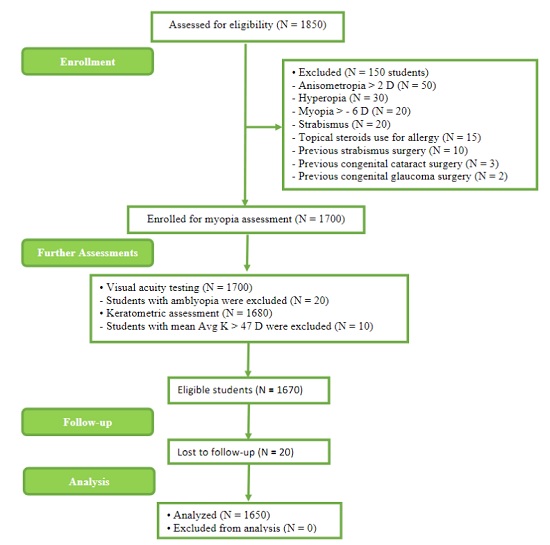Stay-at-home myopia among school children during the COVID-19 pandemic
Medical hypothesis, discovery & innovation in optometry,
Vol. 3 No. 2 (2022),
29 October 2022
,
Page 48-54
https://doi.org/10.51329/mehdioptometry150
Abstract
Background: Uncorrected myopia represents a major cause of visual disability in children, especially in low-income and middle-income countries. However, there is still debate about the effect of e-learning and “stay-at-home” guidelines on the refractive status of school children, especially in the absence of long-term follow-up data. This study aimed to assess the impact of stay-at-home enforcement during the COVID-19 pandemic on myopia progression in students in the Suez Canal Area, Egypt.Methods: This longitudinal observational study included 1650 students. All students aged 8–15 years with visual complaints, who had attended routine annual vision checks since 2018, were enrolled and assessed annually for myopia progression until 2021. Cycloplegic and noncycloplegic refraction, axial length (AL), corneal curvature, and uncorrected and best-corrected distance visual acuity were measured. The participants were administered a questionnaire that focused mainly on collecting information on their visual habits.
Results: Our study included 3300 eyes of 1650 school students with myopia during the 4-year study period from 2018 to 2021. The mean cycloplegic spherical equivalents (CSE) were - 1.02, - 1.52, - 2.00, and - 3.50 diopters (D) in 2018, 2019, 2020, and 2021, respectively. This myopic shift in CSE over time was significant (P < 0.001). The average keratometric reading (Avg K) increased significantly during the follow-up period (P < 0.001). The Avg K measurements were 42.32, 42.62, 43.02, and 44.19 D in 2018, 2019, 2020, and 2021, respectively. The changes in Avg K were significant (P < 0.001). The mean AL measurements were 22.53, 22.59, 22.69, and 22.71 mm in 2018, 2019, 2020, and 2021, respectively. Although statistically significant (P < 0.001), changes in AL were clinically insignificant throughout the study period. The mean durations spent on electronic devices at home were 2.12, 2.46, 3.10, and 6.00 hours in 2018, 2019, 2020, and 2021, respectively. The changes over time were significant (P < 0.001).
Conclusions: During the COVID-19 pandemic, studying at home accelerated the degree of refraction toward myopia in school children in Egypt. Further studies are needed to assess the academic performance of students with progressive myopia.
Keywords:
- myopia
- stay at home orders
- health lockdown
- COVID-19 pandemic
- corneal topography
- eye axial length
- visual acuity
- ocular refraction

- Abstract Viewed: 0 times
- Full Text PDF Downloaded: 0 times